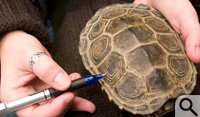Are we losing terrapins to crab pots?
Megan Rook, a graduate student in William and Mary’s Department of Biology, has received $20,000 in funding to allow her to continue her studies of diamondback terrapins.
The grant funds came from the National Oceanic and Atmospheric Administration and the National Estuarine Research Reserve System. Rook is  working with faculty advisor Randy Chambers of William and Mary’s W.M. Keck Environmental Field Laboratory.
working with faculty advisor Randy Chambers of William and Mary’s W.M. Keck Environmental Field Laboratory.
Rook’s project examines the effects of the Chesapeake Bay blue-crab fishery on the diamondback terrapin population. Although associated closely with the state of Maryland, the diamondback terrapin’s range extends along the Atlantic and Gulf coasts from Cape Cod to Texas, including Virginia and the Chesapeake Bay. Terrapins live only in estuaries and other brackish-water habitats.
“The blue crab industry is huge in the Chesapeake Bay and the turtles can get into the crab pots and they get stuck in there and they drown,” Rook said. “This is becoming a very big threat in certain parts of the terrapin’s range.”
Terrapins have such a fascination for crab pots—submerged wire mesh traps—that they will enter them if the pots are unbaited, Rook said. “Actually the easiest way to catch a terrapin is with a crab pot, so we go and we put out a bunch of crab pots but we modify them,” she explained. “We cut a hole in the top of the pot and then build a chimney.”
The traps are placed in water shallow enough for the chimney to stick out of the water at high tide, allowing trapped terrapins to swim up and reach open air to breathe. Rook weighs and measures the upper shell, or carapace, of the terrapins before releasing them.
This summer, Rook will compare terrapin populations and their relative vulnerability to crabbing at two York River locations. One is Felgate’s Creek, within the Yorktown Naval Weapons Station, where crabbing has been prohibited for decades. The second is at the Goodwin Islands, a research reserve site at the mouth of the York River managed by the Virginia Institute of Marine Science.
Rook said that though the diamondback terrapin were fished out during the early 1900s, the species has made a comeback through most of its range, including the York River. Today, terrapins face other dangers than crabbing, she said, citing road deaths and predation, especially of nests, by raccoons.
“They are not endangered. We have a good population in the York River. State by state they are listed differently as either threatened or species of special concern,” she said. “One of the things I really like about this project is that the terrapin is not endangered yet and I think it’s an efficient thing to do to try to catch the problem before it starts to spiral out of control and they do become endangered.”
Rook has been continuing work started by Matthew Wolak, who graduated in 2007. She will assemble a team of undergraduates to assist in the project this summer.
“Once again, the mixture of excellent graduate students and undergraduate researchers that is unique to William and Mary is helping advance science on a regional and national level,” said George Gilchrist, director of graduate studies in William and Mary’s Department of Biology. 
















